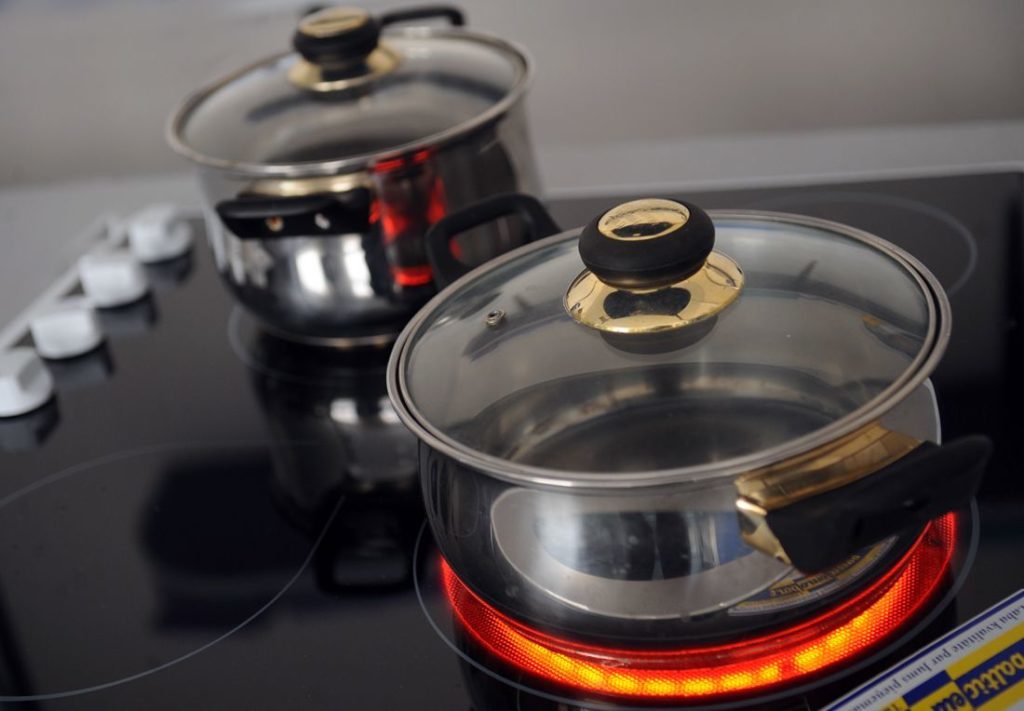A glass ceramic plate will delight the owner not only with a modern design, but also with a set of useful options, ergonomics and comfort in use. However, such an acquisition raises the question: what utensils can be used on it. Read about the distinguishing features of kitchen appliances and the choice of utensils for it in our material.
Features of plates with a glass-ceramic surface
The content of the article
- Features of plates with a glass-ceramic surface
- What pots are suitable for a glass ceramic surface
- What utensils should not be used and why
Cooktops of this type are made of glass according to a special technique, so they have excellent indicators of strength, resistance to high temperatures and are characterized by durability. They are distinguished by an even coating, which is easily cleaned of contaminants.
There are two main types of devices: with a conventional heating device (TEN), from which heat extends to the burner, and with a special coil heating only the bottom of the dishes - induction slabs.
Advantages of models:
- Burners work with high efficiency, their heating and cooling are much faster than on standard stoves. The temperature rises only in the area of the heating element, which eliminates the risk of burns.
- The heat comes in a vertical direction, due to this, the bottom of the dishes instantly warms up, and extra time is not wasted on cooking (for example, the liquid boils in a few minutes).
- Low power consumption and low power will save on additional energy costs.
- A variety of built-in functions allow you to cook food for every taste.
What pots are suitable for a glass ceramic surface
The main disadvantage of such kitchen devices is the need for careful selection of accessories. They can be made from the following raw materials:
- stainless steel is the best option, provides high heat conductivity, easy to clean;
- steel dishes with enamel coating - has excellent characteristics;
- aluminum products, if their bottom is made of Teflon.
Attention! Induction cookers can only work with containers, the lower part of which is made of stainless steel, cast iron or special magnetic raw materials. The material of the walls and the cover does not matter here.
Compliance with the selection of dishes will ensure the perfect operation of the kitchen appliance:
- the bottom should be perfectly flat and sufficiently thick (2-3 layers), it is imperative to match the size of the burners;
- strong and thick walls should maintain the temperature and taste of the prepared dishes for a long time;
- matte surface, dark or black color of the bottom perfectly conduct heat and practically do not reflect it - this will speed up the cooking process;
- it is permissible to use containers with a concave bottom, if it rises when the temperature rises.
Reference! When choosing cookware options, pay attention to their compatibility with the desired type of devices, this can be found on the data on the label or packaging. In the case of induction panels, a magnet will help: attach it to the bottom of the pan, and if it is attracted, you can safely purchase the goods.

What utensils should not be used and why
There are utensils, the use of which can disrupt the functionality of the device, leave traces or indelible spots on its surface:
- Tanks with an uneven, deformed bottom, the presence of chips or soot, any patterns. They will not be able to warm up correctly, which will increase the time for cooking and the consumption of electricity, they can damage the glass-ceramic coating. These primarily include old pots and pans that were used on gas stoves.
- Sauce pans having a diameter that does not match the size of the burners. Smaller ones will increase energy consumption, and larger ones will lead to overheating of the equipment and can disable it.
- The bottom of a convex or concave shape will not provide sufficient contact with the surface of the plate, this will increase the time spent and adversely affect the taste of the food.
- Copper or aluminum products (if they do not have additional protective layers) during heating can spoil the surface, leaving stubborn stains.
- Apparently suitable materials, glass and ceramics, in fact, have low thermal conductivity, lengthen the cooking procedure, so it is better not to use them.
- Enameled dishes with a metal mirror effect will increase the cooking time due to heat reflection and are not suitable for use.
Reference! Recommendations for a specific model can be found in the attached instructions or on the manufacturer's website.
The right choice of dishes will ensure the efficient operation of the hob and eliminate unnecessary problems. Follow our tips, and a new stove in your kitchen will pleasantly surprise you with its reliability and high quality cooking.


